- Blown Glass
- Blown glass is made by forcing air into glass to shape it.
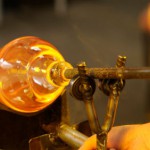
Wikimedia commons glass blowing
- Blown glass is made by forcing air into glass to shape it.
- Cabochons
- Cabochans, also known as jewels are made by pouring glass into compact molds to create variously colored jewels.
- Confetti Glass
- Confetti Glass, also called Fractured Glass, is formed by embedding bits of colored glass into a molten sheet of glass and rolling it on a marver. This technique is used in a lot of landscape and floral subjects.
- Crizzled Glass
- Crizzled glass is a form of degradation of glass that is caused by an uneven amount of ingredients in the glass. Specifically too much alkali or too little stabilizer can be detrimental to glass.
- Deionized Water
- Water that has had the ions removed, basically uncontaminated water used for cleaning the window so as not to damage it.
- Devitrification
- When crystallization occurs in glass, usually on the surface from when it’s cooling or if it is heated again.
- Drapery Glass
- Drapery glass mimics the folds in clothing, and occasionally flowers, and replaced the need to paint in that kind of detail. In order to create this effect, artists have to pour molten glass onto a marver and then manipulate it with tools to create folds.
- Ecclesiastical Artwork
- A work of art made for a place of worship.
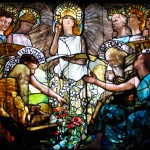
Example of Ecclesiastical Artwork (“Education” by Louis Comfort Tiffany)
- A work of art made for a place of worship.
- Feather Glass
- As the name would suggest, it is a type of glass that is mostly used for the feathers of the wings of angels. It is similar to drapery glass in that it is manipulated glass to decrease the need for paint. It can also be used for texture in florals.
- Flashed Glass
- Flashed glass is creating by pouring a thin layer of glass over another, each with two different colors.
- Hammered Glass
- Created by moving glass through textured rollers. This effect is created in order to diffuse light and is usually placed underneath another plate for an added sense of depth.
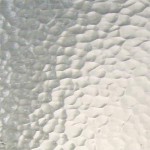
Example of Hammered Glass
- Created by moving glass through textured rollers. This effect is created in order to diffuse light and is usually placed underneath another plate for an added sense of depth.
- Leaded Glass Windows
- This is an arrangement of glass pieces that use lead or other metal materials as both structure and aesthetic. This technique is most commonly seen in stained glass windows.
- Marver
- Flat surface where glass is rolled usually made of polished steel.
- Mottled/Spotted Glass
- Through the addition of the element fluorine, glass undergoes crystallization for the illusion of texture in flowers or sun-splashed leaves.
- Opalescent Glass
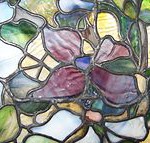
Close-up of Opalescent glass from Tiffany Lamp
- Invented by John LaFarge, one of Tiffany’s main rivals, this innovative technique creates a milky and iridescent colored glass.
- Painted Glass
- The process of painting directly on the glass. Tiffany tried not to overuse this technique because he thought it didn’t let enough light through, but it was used in Tiffany windows, primarily for faces, hands, and feet.
- Plated Glass
- This technique is used to create a sense of depth and is achieved by using layers of glass to create an image. One problem with this technique is it can be very heavy and cause the windows to bow, also it is possible for debris and water to get inbetween the layers.
- Provenance
- Where something comes from, who has owned it.
- Ripple Glass
- Glass moved on rollers on a marver.
- Stained Glass Windows
- This generic term is used to describe decorative windows that are created through pieces of variously colored glass being fitted into cames, or dividing bars.
- Streamer Glass
- Fusing thin rods of glass to molten glass on a marver.
- Tiffany Glass and Decorating Company
- Louis Comfort Tiffany re-establishes his old company with this new name in 1892 to expand into “fancy goods.”
- Triple Lancet Windows
- This is a stylistic feature that entails three windows grouped together that form a pointed arch at the top.
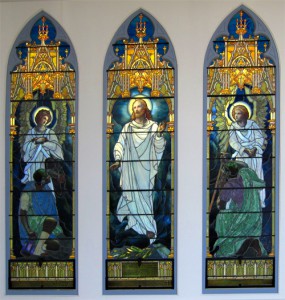
Example of Triple Lancet Windows (Christ Resurrection)
- This is a stylistic feature that entails three windows grouped together that form a pointed arch at the top.
Citations
Frederick Wilson – Tiffany Glass & Decorating Company, Christ Resurrection Window, 1900. Leaded glass, paint. Virginia Museum of Fine Arts.
“Glass Dictionary.” Corning Museum of Glass. Accessed June 06, 2015. http://www.cmog.org/research/glass-dictionary.
Frelinghuysen, Alice Cooney, and Monica Obniski. “Louis Comfort Tiffany (1848–1933).” Heilbrunn Timeline of Art History. New York: The Metropolitan Museum of Art, 2000–. (July 2007) http://www.metmuseum.org/toah/hd/tiff/hd_tiff.htm.
“Q & A: What Is Deionized Water?” Department of Physics: University of Illinois at Ubana-Champaign. Accessed June 06, 2015. https://van.physics.illinois.edu/qa/listing.php?id=1743.
Trachtenberg, Marvin, and Isabell Hyman. Architecture, From Prehistory to Postmodernity: The Western Tradition, 2nd Ed. Englewood Cliffs, N.J.: Prentice-Hall; New York: H.N. Abrams, 2002.
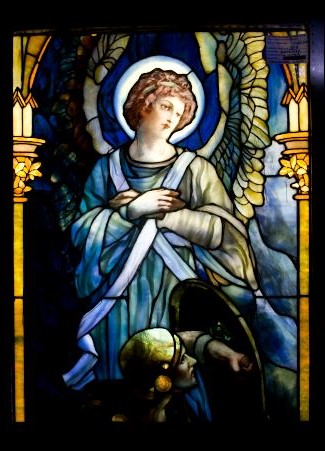
Exploring Tiffany Windows.
Ready to learn more? Following the links below to explore!